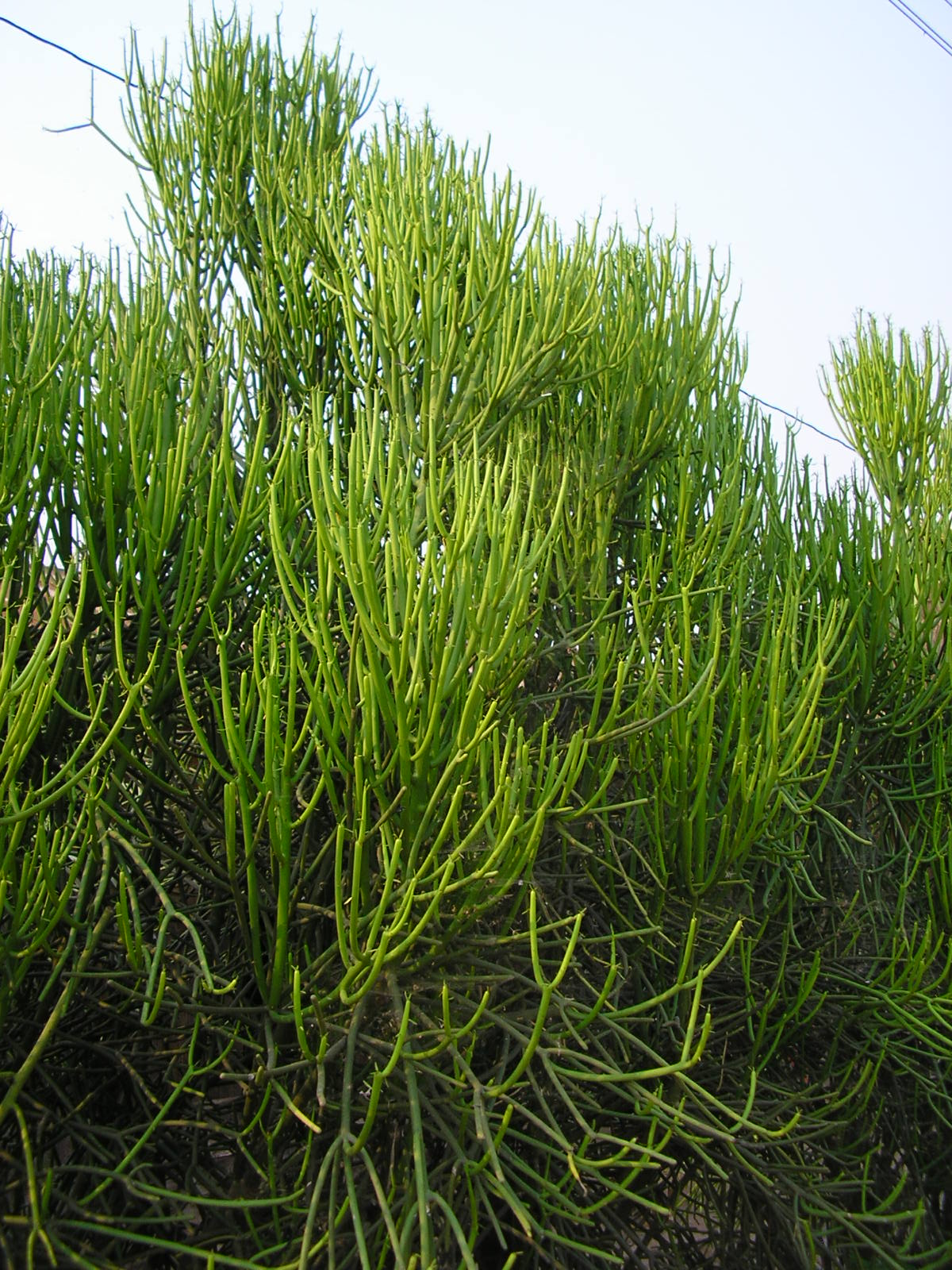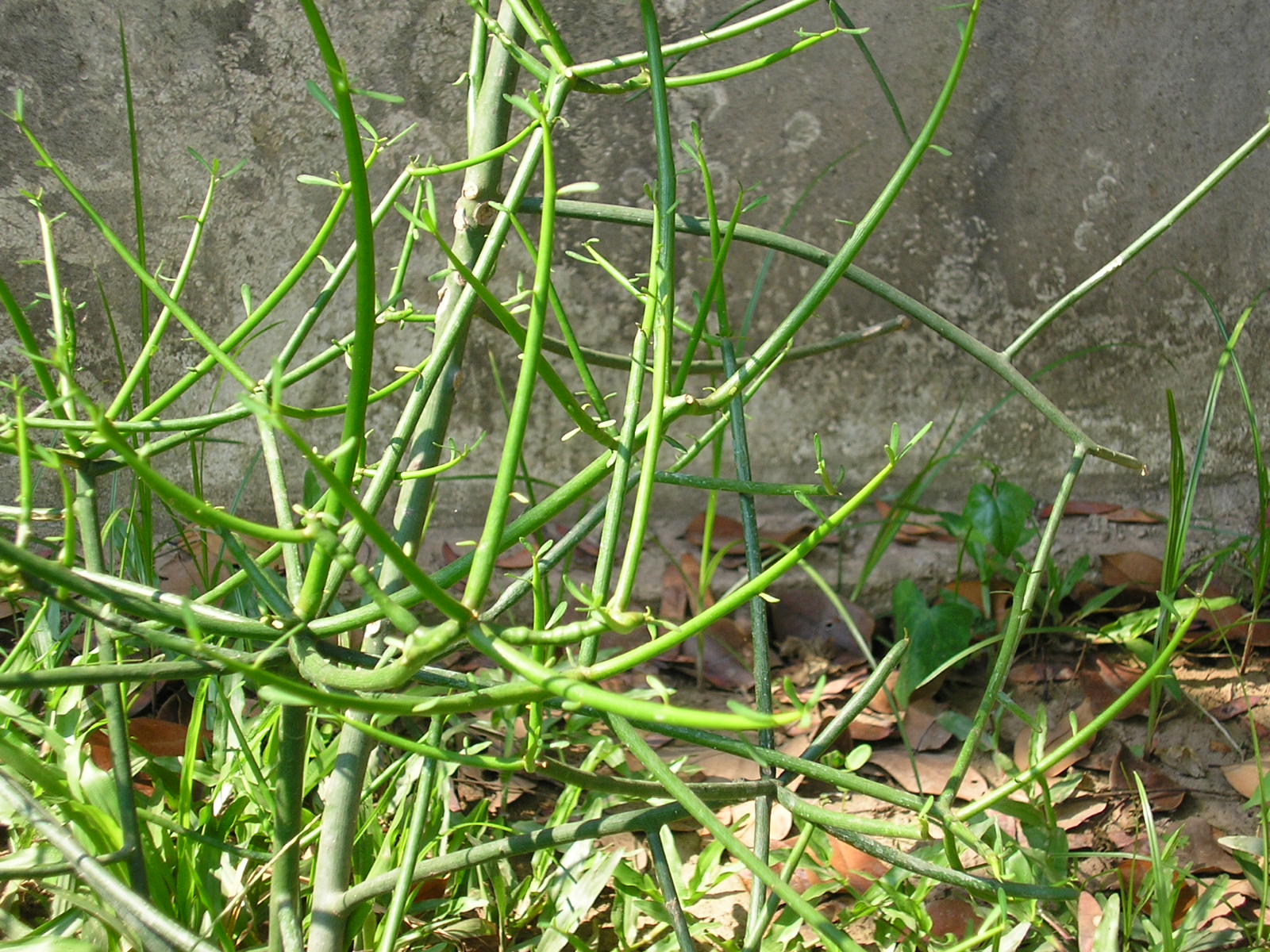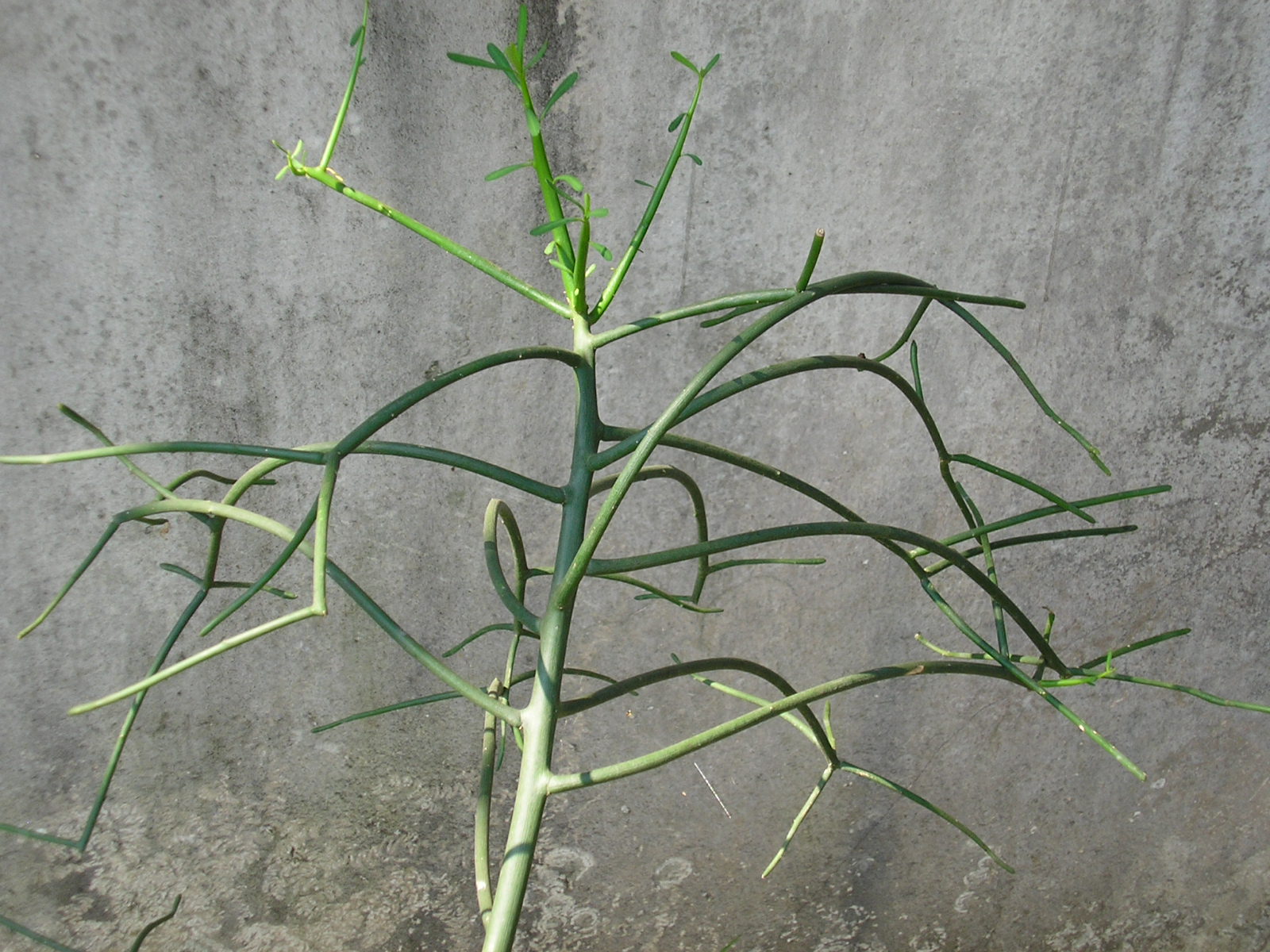The Euphorbia genus is the most representative of the Euphorbia family, which includes shrubs with medicinal, decorative and magical properties. They have in common to be sometimes confused with cacti for their thorns and their tortuous shape and to have a more or less caustic white sap reputed to be curative. The botanical name Euphorbia derives from that of the Greek doctor of King Juba II of Numidia who was called Euphorbus.
Euphorbia tirucalli originates from Madagascar but has been cultivated for a very long time in tropical Asia. It is a shrub of 4 to 7 meters with a trunk the size of the wrist, with numerous green, spindly, barely leafy branches.
The shape of its stems has determined most of its vernacular names: the Lao call it “three thousand stems“, the French “Euphorbe crayon” and the English “Pencil Bush” or “Milky Bush”.
Another characteristic of this plant is its abundant highly toxic latex, a drop of which is said to cause blindness. As often, the toxicity of the sap will be used for medicinal purposes. In Laos it is used to treat dermatoses and a decoction of the roots is used in case of haemorrhoids.
It was recently discovered that this latex could be transformed without much manipulation into biofuel; this is all the more interesting as this plant is very hardy and grows where no other plant does. Brazil is experimenting with this new source of green fuel.
Le genre Euphorbia est le plus représentatif de la famille des Euphorbes qui comporte des arbustes aux vertus médicinales, décoratives et magiques. Ils ont en commun d’être parfois confondus avec des cactus pour leurs épines et leur forme tortueuse et d’avoir une sève blanche plus ou moins caustique réputée curative. Le nom botanique Euphorbia dérive d’ailleurs de celui du médecin grec du roi Juba II de Numide qui s’appelait Euphorbus.
Euphorbia tirucalli est originaire de Madagascar mais elle est cultivée depuis très longtemps en Asie tropicale. C’est un arbuste de 4 à 7 mètres au tronc de la grosseur du poignet, aux rameaux nombreux verts, grêles, à peine feuillés.
L’allure de ses tiges a déterminé la plupart de ses noms vernaculaires: les Lao le nomment « trois mille tiges », les Français « Euphorbe crayon » et les anglais pencil bush, « buisson de crayons » ou milky bush, « buisson laiteux ».
Une autre caractéristique de cette plante est son abondant latex très toxique dont on dit qu’une goutte peut rendre aveugle. Comme souvent, la toxicité de la sève sera utilisée à des fins médicinales. Au Laos, on s’en sert pour soigner les dermatoses et on utilise une décoction des racines en cas d’hémorroïdes.
On a récemment découvert que ce latex pouvait être transformé sans beaucoup de manipulations en biocarburant; ceci est d’autant plus intéressant que cette plante est très rustique et pousse là où aucune autre plante ne se plaît. Le Brésil est en train d’expérimenter cette nouvelle source de carburant vert.



The Euphorbia genus is the most representative of the Euphorbia family, which includes shrubs with medicinal, decorative and magical properties. They have in common to be sometimes confused with cacti for their thorns and their tortuous shape and to have a more or less caustic white sap reputed to be curative. The botanical name Euphorbia derives from that of the Greek doctor of King Juba II of Numidia who was called Euphorbus.
Euphorbia tirucalli originates from Madagascar but has been cultivated for a very long time in tropical Asia. It is a shrub of 4 to 7 meters with a trunk the size of the wrist, with numerous green, spindly, barely leafy branches.
The shape of its stems has determined most of its vernacular names: the Lao call it “three thousand stems“, the French “Euphorbe crayon” and the English “Pencil Bush” or “Milky Bush”.
Another characteristic of this plant is its abundant highly toxic latex, a drop of which is said to cause blindness. As often, the toxicity of the sap will be used for medicinal purposes. In Laos it is used to treat dermatoses and a decoction of the roots is used in case of haemorrhoids.
It was recently discovered that this latex could be transformed without much manipulation into biofuel; this is all the more interesting as this plant is very hardy and grows where no other plant does. Brazil is experimenting with this new source of green fuel.
Le genre Euphorbia est le plus représentatif de la famille des Euphorbes qui comporte des arbustes aux vertus médicinales, décoratives et magiques. Ils ont en commun d’être parfois confondus avec des cactus pour leurs épines et leur forme tortueuse et d’avoir une sève blanche plus ou moins caustique réputée curative. Le nom botanique Euphorbia dérive d’ailleurs de celui du médecin grec du roi Juba II de Numide qui s’appelait Euphorbus.
Euphorbia tirucalli est originaire de Madagascar mais elle est cultivée depuis très longtemps en Asie tropicale. C’est un arbuste de 4 à 7 mètres au tronc de la grosseur du poignet, aux rameaux nombreux verts, grêles, à peine feuillés.
L’allure de ses tiges a déterminé la plupart de ses noms vernaculaires: les Lao le nomment « trois mille tiges », les Français « Euphorbe crayon » et les anglais pencil bush, « buisson de crayons » ou milky bush, « buisson laiteux ».
Une autre caractéristique de cette plante est son abondant latex très toxique dont on dit qu’une goutte peut rendre aveugle. Comme souvent, la toxicité de la sève sera utilisée à des fins médicinales. Au Laos, on s’en sert pour soigner les dermatoses et on utilise une décoction des racines en cas d’hémorroïdes.
On a récemment découvert que ce latex pouvait être transformé sans beaucoup de manipulations en biocarburant; ceci est d’autant plus intéressant que cette plante est très rustique et pousse là où aucune autre plante ne se plaît. Le Brésil est en train d’expérimenter cette nouvelle source de carburant vert.






The Euphorbia genus is the most representative of the Euphorbia family, which includes shrubs with medicinal, decorative and magical properties. They have in common to be sometimes confused with cacti for their thorns and their tortuous shape and to have a more or less caustic white sap reputed to be curative. The botanical name Euphorbia derives from that of the Greek doctor of King Juba II of Numidia who was called Euphorbus.
Euphorbia tirucalli originates from Madagascar but has been cultivated for a very long time in tropical Asia. It is a shrub of 4 to 7 meters with a trunk the size of the wrist, with numerous green, spindly, barely leafy branches.
The shape of its stems has determined most of its vernacular names: the Lao call it “three thousand stems“, the French “Euphorbe crayon” and the English “Pencil Bush” or “Milky Bush”.
Another characteristic of this plant is its abundant highly toxic latex, a drop of which is said to cause blindness. As often, the toxicity of the sap will be used for medicinal purposes. In Laos it is used to treat dermatoses and a decoction of the roots is used in case of haemorrhoids.
It was recently discovered that this latex could be transformed without much manipulation into biofuel; this is all the more interesting as this plant is very hardy and grows where no other plant does. Brazil is experimenting with this new source of green fuel.
Le genre Euphorbia est le plus représentatif de la famille des Euphorbes qui comporte des arbustes aux vertus médicinales, décoratives et magiques. Ils ont en commun d’être parfois confondus avec des cactus pour leurs épines et leur forme tortueuse et d’avoir une sève blanche plus ou moins caustique réputée curative. Le nom botanique Euphorbia dérive d’ailleurs de celui du médecin grec du roi Juba II de Numide qui s’appelait Euphorbus.
Euphorbia tirucalli est originaire de Madagascar mais elle est cultivée depuis très longtemps en Asie tropicale. C’est un arbuste de 4 à 7 mètres au tronc de la grosseur du poignet, aux rameaux nombreux verts, grêles, à peine feuillés.
L’allure de ses tiges a déterminé la plupart de ses noms vernaculaires: les Lao le nomment « trois mille tiges », les Français « Euphorbe crayon » et les anglais pencil bush, « buisson de crayons » ou milky bush, « buisson laiteux ».
Une autre caractéristique de cette plante est son abondant latex très toxique dont on dit qu’une goutte peut rendre aveugle. Comme souvent, la toxicité de la sève sera utilisée à des fins médicinales. Au Laos, on s’en sert pour soigner les dermatoses et on utilise une décoction des racines en cas d’hémorroïdes.
On a récemment découvert que ce latex pouvait être transformé sans beaucoup de manipulations en biocarburant; ceci est d’autant plus intéressant que cette plante est très rustique et pousse là où aucune autre plante ne se plaît. Le Brésil est en train d’expérimenter cette nouvelle source de carburant vert.


